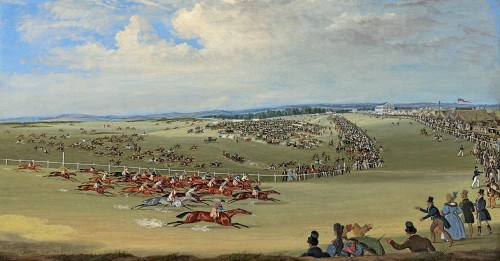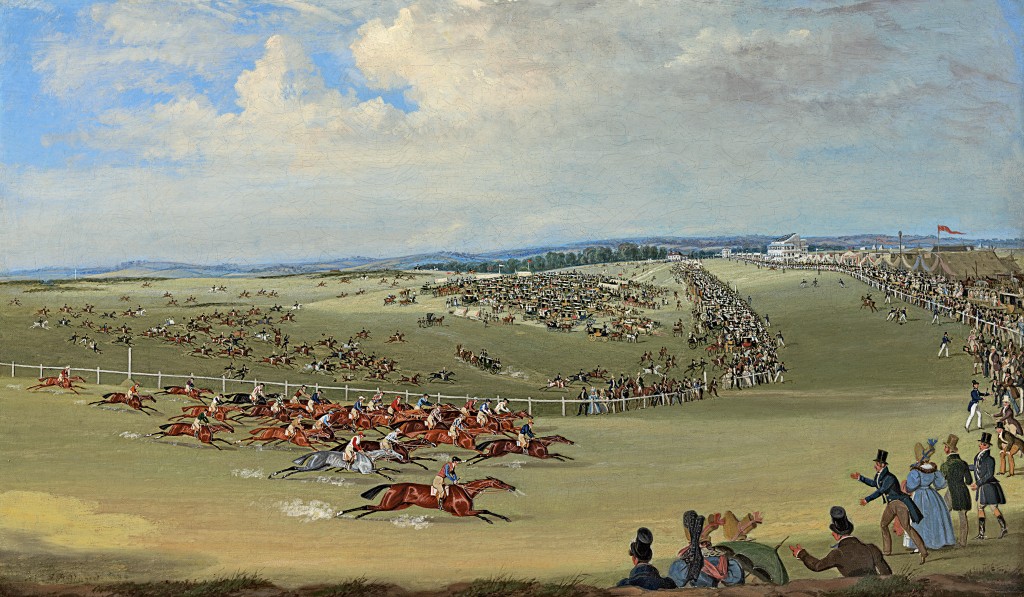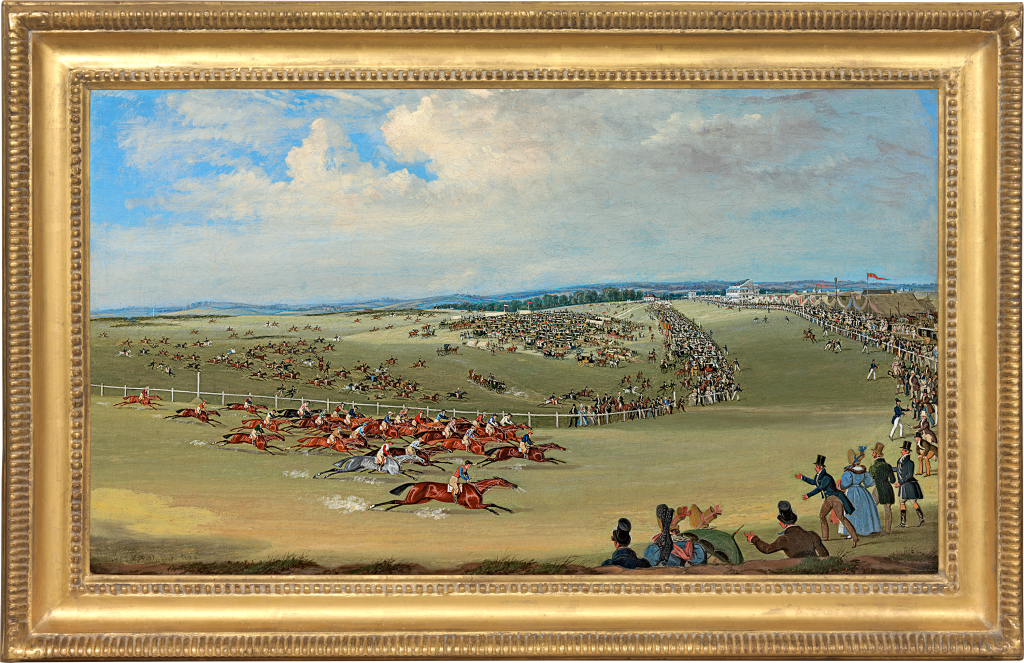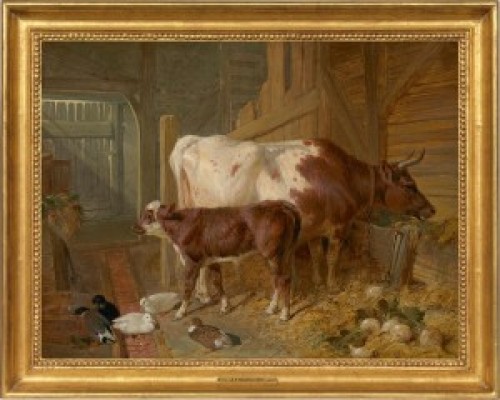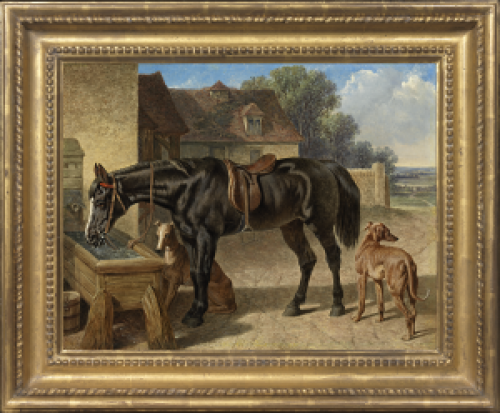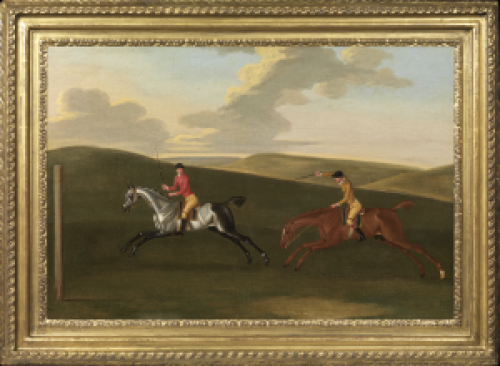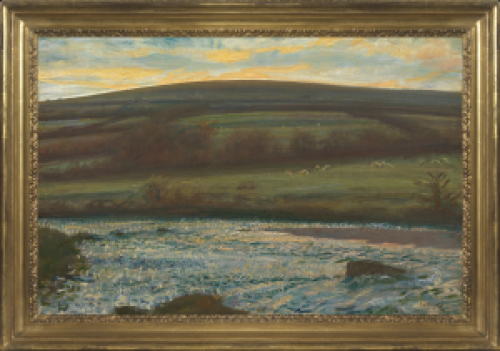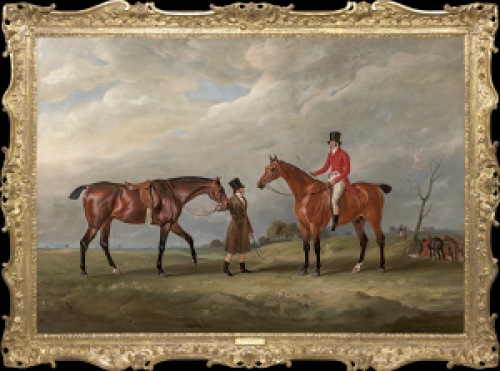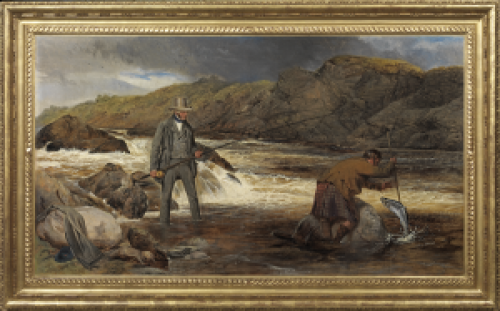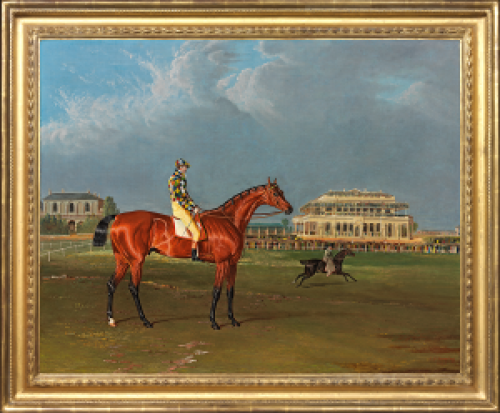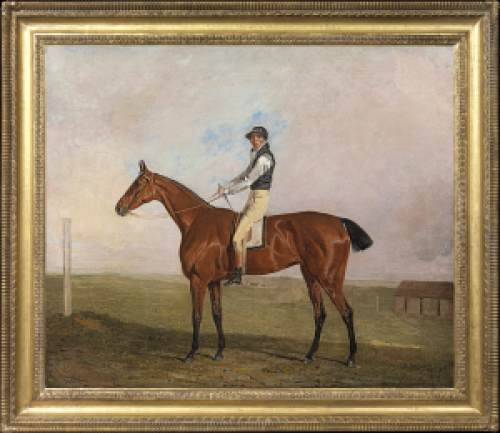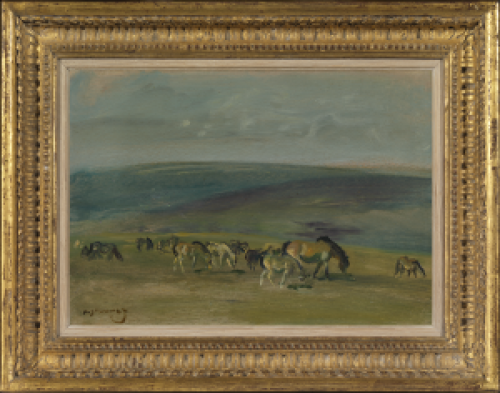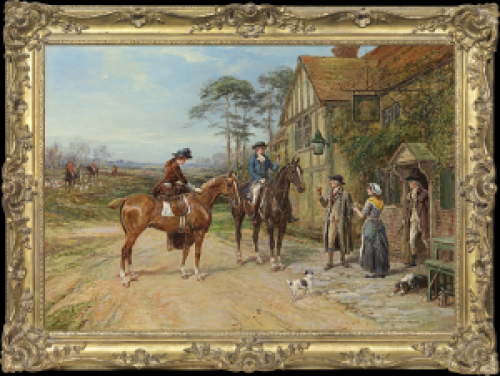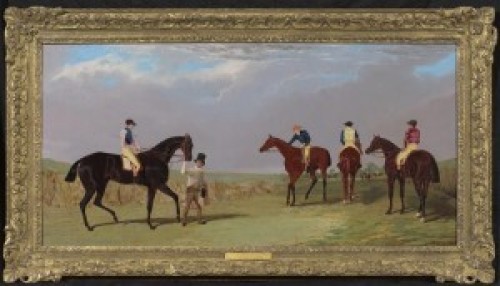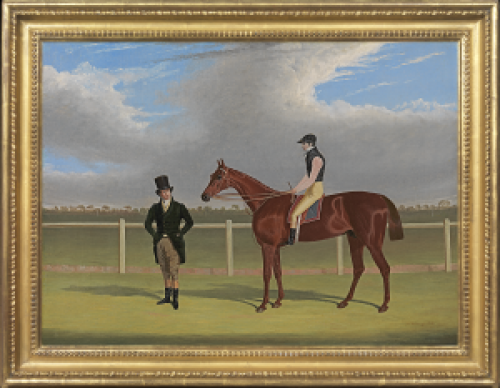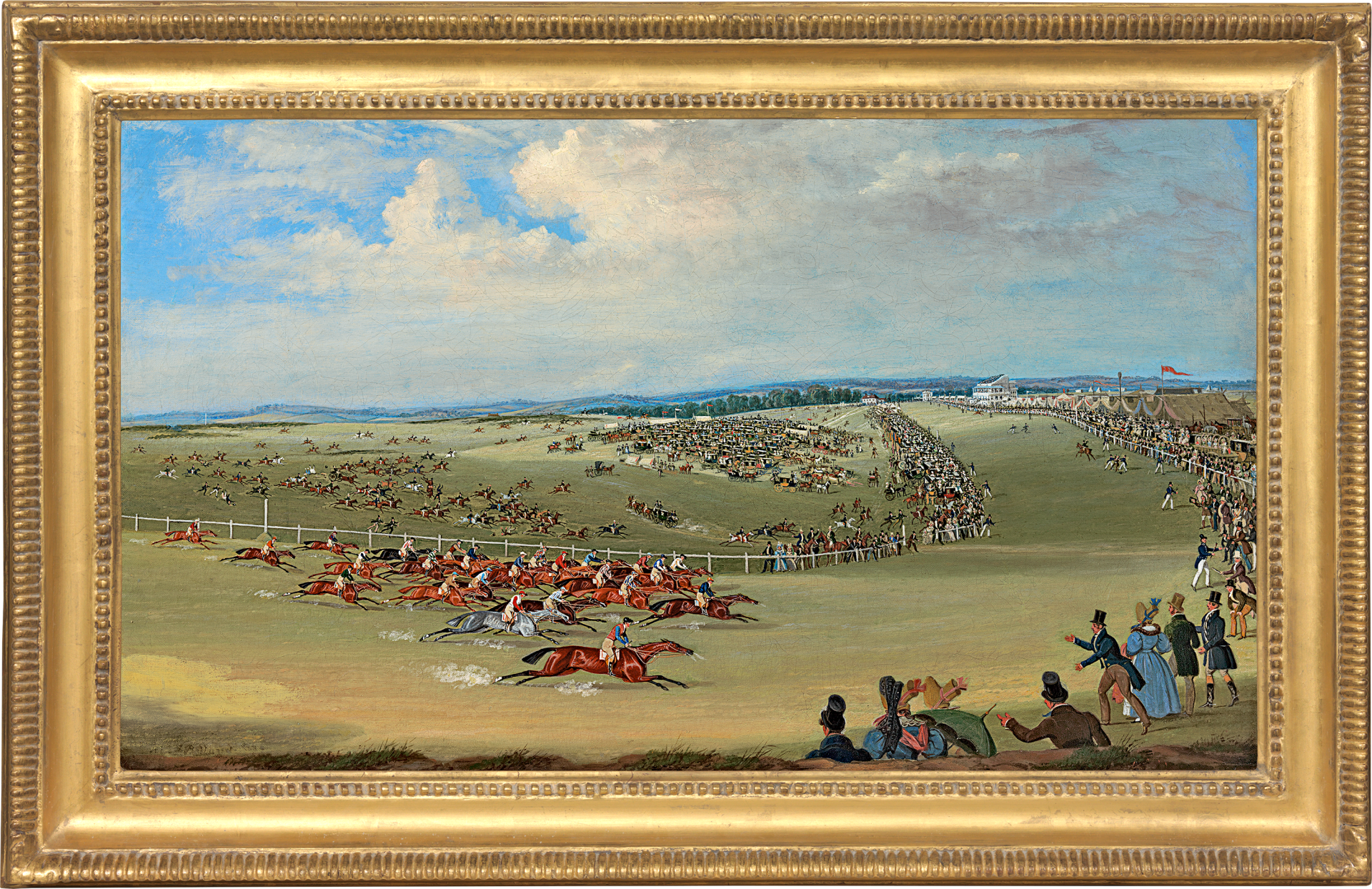JAMES POLLARD
Islington 1792 - 1867 Chelsea
Ref: CD 102
The Derby, Epsom, 23rd May 1833: here they come, passing Tattenham Corner
Signed and dated lower left: J. Pollard 1834
Oil on canvas: 14 x 24 in / 35.6 x 61 cm
Frame size: 18 x 28 in / 45.7 x 71.1 cm
In an eighteenth century style carved and gilded hollow frame
Engraved:
By Smart and Hunt, published on 2nd June 1834 by S and J Fuller
Provenance:
Sotheby’s London, 8th March 1989, lot 142;
Richard Green, London, 1989;
private collection, Pennsylvania, USA;
Exhibited:
London, Richard Green, Annual Exhibition of Sporting Paintings, 1989, no.11, illus. in colour
Literature:
NC Selway, James Pollard 1792-1867, Painter of the Age of Coaching, Leigh-on-Sea 1965, p.43, no.172 (as Passing Tattenham Corner)
NC Selway, The Golden Age of Coaching and Sport as Depicted by James Pollard, Leigh-on-Sea 1972, p.35, no.192 (as Here they come: passing Tattenham Corner)
G Budd, Racing Art and Memorabilia: a Celebration of the Turf, London 1997, pp.53, 58-59, illus. in colour
The Derby is and remains one of the most vibrant fixtures in the racing calendar, today held in early June before the great social event of Royal Ascot later in the month. First run on the Epsom course in 1780, it was named after Edward Stanley, 12th Earl of Derby (1752-1834), a Jockey Club stalwart who owned a nearby house, The Oaks. Like its fellow Classic race, the St Leger, the Derby captured the imagination of both painters and writers. A rich melting pot of all levels of English society, it was fictionalized by Dickens and Disraeli and celebrated in William Powell Frith’s Derby Day, 1856-58 (Tate Britain) and the paintings of Sir Alfred Munnings.
James Pollard established his reputation as a painter of coaching scenes, switching to racing subjects when coaching declined with the advent of the railways. This painting depicts the field of 1833 sweeping towards Tattenham Corner before entering the final straight which will decide the victor. The race was won by Mr Isaac Sadler’s chestnut colt Dangerous, by Tramp out of Defiance. The favourite for the Derby, at 3-1, was Glaucus, owned by the notorious race-fixer Robert Ridsdale. Dangerous, ‘a large bony horse, deep in girth with powerful limbs’[1], started at 30-1. His jockey, the quiet, unassuming Devonian Jem Chapple, kept him in the rear in the early stages, moving up after Tattenham Corner. He was challenged by Connoisseur in the last hundred yards but won easily by a length. Chapple stated afterwards that Dangerous ‘was lame at the start and he would not have given a pint of porter for his chances; however, the stiffness wore off during the race’[2]. Although he walked over for sweepstakes at Stockbridge and Winchester, Dangerous did not run again; he was sent to stud at Prestbury and in 1825 he was purchased by the French Government and sent to stud.
Pollard gives an amusing evocation of an early nineteenth century Derby in all its chaotic exuberance, with fashionable spectators spilling onto the track despite the attempts of the stewards to restrain them. On the far side of the track, mounted gentlemen race to keep up with the field, careless of life and limb. One unfortunate lady has been ejected from her carriage while her horse races on and she lies spreadeagled before the blue heavens. Further back, the gentry enjoy the race from their carriages.
The painting was engraved by Smart and Hunt, published on 2nd June 1834 by S and J Fuller, feeding the Georgian enthusiasm for depictions of horseracing and bringing Pollard’s work to a wide public. Pollard painted three other works in 1834 depicting the progress of the 1833 Derby: Now they’re off, Start for the Derby Stakes and There they are[3].
JAMES POLLARD
Islington 1792 - 1867 Chelsea
James Pollard established his reputation as a painter of coach scenes, which represent a valuable pictorial documentation of the coaching era. With the demise of the coach and the onset of the railway, Pollard expanded his subject matter to include racing, hunting, shooting and angling scenes.
Pollard was the son of the Newcastle-born engraver and print publisher Robert Pollard (1755/6-1839), a pupil of Richard Wilson, and grew up on the main northern coaching route which ran through Islington and Holloway. He was trained as a painter and engraver by his father and received instruction from the wood engraver Thomas Bewick, his father’s friend and also a Newcastle man. James worked in the family firm as a draughtsman and engraver.
In 1821, an event occurred that altered Pollard’s future. The King’s printseller Edward Orme commissioned him to paint an inn signboard showing a mail coach with horses and passengers. This signboard was first displayed in Orme’s Bond Street shop window, where it was seen by the Austrian Ambassador Prince Esterházy, who ordered a replica on canvas. This led to many commissions for coaching scenes. In 1825 Pollard married Elizabeth Ridley. In the 1830s Pollard concentrated exclusively on painting. He collaborated with John Frederick Herring Snr (1795-1865), providing landscape backgrounds, buildings and crowds for racing scenes such as The Doncaster Great St Leger, 1839. Pollard exhibited at the Royal Academy between 1821 and 1839, the British Institution between 1824 and 1844, and at the Suffolk Street Galleries. Many of his works were engraved.
In 1840 Pollard was devastated by the death of his wife and youngest daughter. He ceased painting; when he resumed, demand for his work had slackened. For the last years of his life he received support from the Artists’ Benevolent Institution and lived with his son James Robert Pollard in Chelsea, where he died on 15th October 1867.
The work of James Pollard is represented in the Royal Collection; Brodick Castle, Scotland and the South African National Gallery.
[1] Michael Church, The Derby Stakes, Compton 2006, p.170.
[2] Roger Mortimer, The History of the Derby Stakes, London 1973, p.106.
[3] NC Selway, James Pollard 1792-1867, Painter of the Age of Coaching, Leigh-on-Sea 1965, p.43, no.170, 171 and 173.

